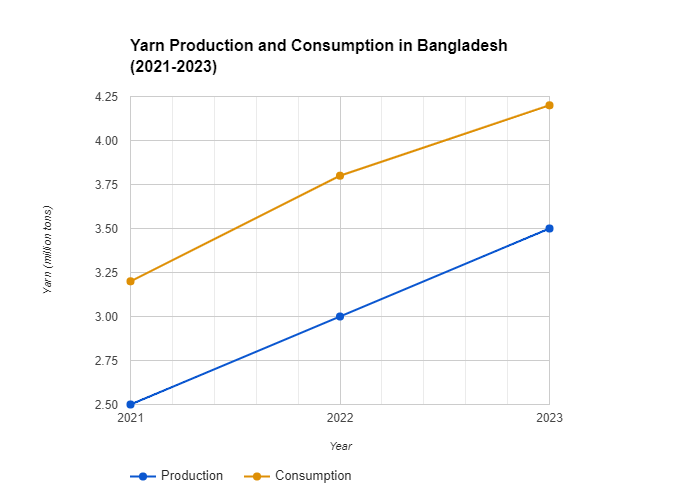Local Yarn Sourcing: A game-changer for Bangladesh's garment sector.
The Bangladesh garment industry, a global readymade garments powerhouse, is increasingly exploring local sourcing of yarn to strengthen its supply chain and enhance sustainability. As Md. Reazul Ahsan, President, BTMA explains, "Sourcing yarn locally is not just about cost, it's about building a resilient and sustainable supply chain for the future of Bangladesh's garment industry."
Indeed, sourcing locally has its advantages as it reduces logistics and import costs freeing up capital for investments in technology, design, and worker well-being. Also, transitioning to local sourcing might require upfront investments in partnerships and quality control measures.
In fact some garment makers are already looking to source more domestic yarn. For example, like MEZ Denim, a Bangladeshi denim manufacturer, partnered local yarn suppliers to reduce lead times and ensure quality control, leading to increased efficiency and cost savings. "The challenge is to ensure quality and competitiveness while transitioning to local sourcing. Collaboration between manufacturers, suppliers, and the government is key," says Fahmida Khatun, CEO, MEZ Denim.
And some like local yarn makers like, Noman Group, a textile conglomerate, has invested in modernizing its spinning mills, enabling them to produce high-quality, specialized yarns, competing effectively with international suppliers. Indeed, the advantages are many but challenges exist, and potential impacts on various stakeholders need careful consideration.
Challenges and threats
Despite its intention to move to local sourcing there are many hiccups. Some of these are:

Limited yarn production capacity: Ensuring consistent yarn quality across local suppliers requires robust quality control measures and industry-wide standards. At the moment, Bangladesh faces a shortfall in yarn production capacity, which could lead to supply shortages and price fluctuations. Bangladesh's yarn production capacity lags behind garment manufacturing. Maintaining consistent yarn quality from local sources demands stringent quality control measures and adherence to industry standards is important.
Table: Yarn production and consumption in Bangladesh (2021-2023):
|
Year |
Yarn production (million tons) |
Yarn consumption (million tons) |
|
2021 |
2.5 |
3.2 |
|
2022 |
3.0 |
3.8 |
|
2023 |
3.5 |
4.2 |
Source: Bangladesh Textile Mills Association (BTMA)
Technological gap: Upgrading local spinning mills is crucial to align with global standards, ensuring competitiveness in terms of product diversity and innovation. Modernization of local spinning mills is crucial to match the capabilities of international suppliers in terms of variety, specialization, and innovation.
Price competitiveness: Up-skilling the local workforce in yarn production and quality control is essential to meet the industry's growing demands. Moreover, balancing cost-effectiveness with quality and sustainability can be challenging, especially when competing with established international suppliers. Also, supportive government policies and efficient logistics infrastructure are necessary to facilitate smooth local yarn sourcing.
Impact of local sourcing on global suppliers
Bangladesh being one of the top global garment is also a major yarn importer. India and China are some of the biggest sources for yarn. However, souring locally will directly impact yarn makers in India and China.
Volume decrease: As Bangladesh sources more yarn locally, yarn imports from India and China are likely to decrease, impacting yarn exporters.
Share decrease: India's share of Bangladesh's yarn imports might shrink, but the overall impact depends on India's ability to adapt and offer competitive value propositions. Similarly, China's share could decrease, but its dominant position in the global yarn market might buffer the impact.
Table: Bangladesh imports from India and China (2021-2023)
|
Year |
India (million tons) |
China (million tons) |
Total Imports (million tons) |
Share in % India |
Share in % China |
|
2021 |
0.8 |
1.5 |
2.3 |
34.78 |
65.22 |
|
2022 |
1.0 |
1.7 |
2.7 |
37.04 |
62.96 |
|
2023 |
1.1 |
1.8 |
2.9 |
37.93 |
62.07 |
Source: Bangladesh Bank Trade Data
The bottomline is local yarn sourcing in Bangladesh does present a promising opportunity for cost savings, sustainability, and supply chain resilience. However, addressing challenges like capacity constraints, quality control, and technological gaps is crucial for success. The potential impacts on fund flow, import volumes, and regional competitors necessitate careful analysis and strategic planning. By embracing innovation, collaboration, and supportive policies, Bangladesh can unlock the full potential of local yarn sourcing and solidify its position as a global leader in the garment industry.
